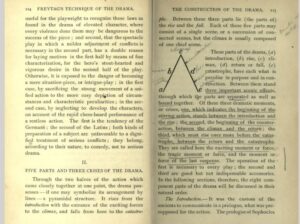When you want to write a story, how would you order the events? What about the characters? When and how would you introduce them to your reader? What about dialogues? How much of the character’s conflict reveal initially? And many more questions which seem daunting and impossible to tackle.
One literary element answers all of these questions: Narrative Structure. It helps you to construct the narration (If you write non-fiction, Text Structure helps you to organize the text. This isn’t the subject of this blog post. In another blog post, I will discuss Text Structure types.
The Narrative Structure is NOT something needed to write screenplays for an action-packed Hollywood movie or a thriller. Any narration, regardless of its length, needs a Narrative Structure.
What is Narrative Structure?
As far as we know, Aristotle, the Greek philosopher, is the first person who tried to answer this question. In his book, POETICS, he wrote:
Aristotle was the first one, but not the only one. About 2100 years after Aristotle, in 1863, Gustav Freytag, the German playwright, and novelist analyzed ancient Greek tragedies and Shakespeare’s works and published his study’s results in a book; DIE TECHNIK DES DRAMAS. In 1894, Elias J. MacEwan translated Freytag’s book into English; FREYTAG’S TECHNIQUES OF THE DRAMA.
Freytag moved our understanding of storytelling forward by drawing a typical narrative form on paper. Today, we call it Freytag’s pyramid, and the term Narrative Arc was initiated from his idea.

The effort for understanding the structure(s) of stories kept playwrights and writers busy. In 1979, an American author, Syd Field, published a book for screenwriting; SCREENPLAY: THE FOUNDATIONS OF SCREENWRITING. As the book’s name indicates, Field discussed the basics of screenwriting; in his opinion, every screenplay should have three parts, as Aristotle said. He explained the content of each part and called it a Three-act Structure.

Although Syd Field’s book is about writing screenplays, it became the bible for any type of storytelling. Not only most screenplays but also most novels are written in the three-act structure. If you don’t have time to read the entire book, I suggest reading at least its first chapter. It is a short chapter, only 15 pages. But it sheds light on the meaning of structure and clears up many misunderstandings.
Before we get to the three-act structure, let’s look at the meaning structure through the eye of Syd Field. He writes (The Foundations of Screenwriting, Syd Field, page 21):
One of the misconceptions about structure is that having structure means following formulas and killing creativity. Syd Field explains that structure is a paradigm and paradigm is a form. Then, with a very subtle example, he shows the difference between a form and a formula (Screenplay: The Foundations of Screenwriting, Syd Field, page 28-29):
Three-act Structure
Three-act structure says a narration consists of three parts (or acts):
- Beginning (or Act I, or Setting)
- Middle (or Act II, or Confrontation)
- End (or Act III, or Resolution)
As a rule of thumb, the Beginning and the End each take 25% of the story and the Middle fills the 50% of the story in between.
Plot Points
An important concept to learn before proceeding further is the meaning of a Plot Point.
Let’s suppose you want to write your memoir and you prepared a timeline of events. These events can be categorized into two: (1) events that changed your life irreversibly. For example, the day you learned to read and write, the day you marry your spouse, even if you divorced later, the day your first child was born, or the day you adopt your child. (2) The second category of the events in your timeline are events that influenced your personality and your life experience but they were not path-determining. For example a memorable journey, or changing workplace. In literature, the first category is called Plot Points, whereas the second category is simply Points in the Plot. If you write the memoir and it is 100 pages but you want to increase the page count to 300 pages, you will need to add more points to the plot (more events from the second category). The number of Plot Points stays constant.
In a nutshell, Plot Points:
- change the direction of the story
- influence the character development
- no-return point; close a door behind a character
Plot Points in the Three-act Structure
The three-act structure tells us how many Plot Points for each act are necessary.

- Beginning
- Inciting Incident (Inciting Event) The event that changes the Protagonist’s world (or main character if you like to call it). This event forces the Protagonist to react.
- Plot Point I The reaction of the Protagonist marks the end of the Beginning.
- Middle
- Pinch Point I Pinch Points give the Protagonist a taste of the obstacles he faces. Depending on the story’s length, a story may not have Pinch Point.
- Midpoint This Plot Point happens about halfway through the story. Thus it is called Midpoint.
- Pinch Point II is similar to Pinch Point I. This Plot Point makes the challenge harder for the Protagonist.
- Plot Point II Even though the Protagonist did his/her best to overcome the obstacles, either there happens a problem or all is lost. Now, the Protagonist should do her best to get to the Plot Goal.
- End
- The climax has the highest level of conflict and the greatest tension where the Protagonist faces the biggest obstacle in the story. She may or may not win.
Example Analysis
To learn how the Narrative Structure works in stories, I have analyzed some picture books, early readers, and chapter books which I found well crafted.
- Sample of picture books link
- Samples of early reader books link
- Sample of picture book biographies link
I write blog posts about the craft of writing picture books (PictureBookPedia) and chapter books (ChapterBookPedia). Also, I publish a quarterly newsletter that includes links to my recent blog posts.

